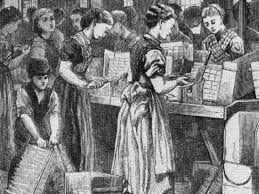“19th-Century Social Reform” – Everything You Need to Know
The 19th century was a period of profound transformation—politically, economically, and culturally. At the heart of these changes were numerous social reform movements that challenged established norms, addressed pressing societal issues, and paved the way for modern welfare systems, labor rights, and democratic ideals. In this comprehensive guide on 19th-Century Social Reform, we’ll explore the origins, key movements, milestones, and lasting impacts of these reforms. Whether you’re a student, history enthusiast, or someone looking to understand how past reforms shape today’s society, this post will provide an in-depth look into the dynamic world of 19th-century social change.
Introduction: A Catalyst for Modern Society
Imagine living in a world where long-held social hierarchies were questioned, where the plight of the working class and the downtrodden spurred passionate calls for change, and where individuals risked everything to secure better lives for future generations. Did you know that many of the social rights we now take for granted—such as safer working conditions, public education, and the right to vote—have their roots in the reform movements of the 19th century?
In this article on 19th-Century Social Reform, we will cover:
- A clear definition of what social reform in the 19th century entailed.
- The historical context and pivotal events that set the stage for these reforms.
- Detailed explorations of key reform movements and their real-world applications.
- The significance and lasting benefits of these social reforms in modern society.
- Common misconceptions and FAQs to clarify misunderstandings.
- Modern relevance and ongoing debates influenced by 19th-century reforms.
Understanding 19th-Century Social Reform is crucial as it not only sheds light on how societies evolve but also informs contemporary discussions about equality, justice, and the role of government in safeguarding public welfare.
What Is “19th-Century Social Reform”?
Defining the Concept
19th-Century Social Reform refers to a wide array of movements and initiatives aimed at addressing the social, economic, and political inequities that emerged during the 1800s. This era was marked by rapid industrialization, urbanization, and significant demographic shifts, which often resulted in challenging living and working conditions for many people.
Key characteristics of 19th-Century Social Reform include:
Addressing Social Inequities:
Reformers sought to remedy issues like poverty, child labor, inadequate education, and unsafe working conditions.Economic Justice:
Movements aimed at fair wages, better labor laws, and the redistribution of wealth to ensure that the benefits of industrial progress were more equitably shared.Political Empowerment:
Many reforms focused on expanding democratic rights, including suffrage for previously marginalized groups, and curbing the influence of entrenched aristocratic and oligarchic power.Moral and Ethical Improvement:
There was a strong emphasis on moral uplift and social responsibility, often inspired by religious and humanitarian values.Grassroots Mobilization:
Social reform was driven by both elite intellectuals and mass movements, involving petitions, protests, and the formation of advocacy groups that sought to influence public policy.
In essence, 19th-Century Social Reform was about reshaping society to create fairer, more humane conditions that would empower individuals and protect the vulnerable.
Historical and Contextual Background
The Landscape of 19th-Century Society
The 19th century was a time of immense change. The Industrial Revolution brought about rapid technological progress and urbanization, but it also led to stark economic disparities, hazardous working conditions, and widespread poverty among the working class. These conditions set the stage for social reform movements that sought to mitigate the negative impacts of industrial progress.
Key Milestones in Social Reform
The Industrial Revolution:
- Economic Transformation:
The shift from agrarian economies to industrialized urban centers created a new class of workers who faced exploitation, long hours, and unsafe conditions. - Urbanization:
As people flocked to cities in search of work, overcrowding and inadequate infrastructure became critical issues, fueling demands for improved public health and housing reforms.
- Economic Transformation:
The Rise of Labor Movements:
- Unionization:
Workers began organizing themselves into unions to demand better wages, shorter workdays, and safer working conditions. The formation of these unions was pivotal in laying the groundwork for modern labor laws. - Legislative Reforms:
Early labor laws, such as those limiting child labor and mandating workplace safety standards, emerged as responses to the harsh realities of industrial work.
- Unionization:
Expansion of Democratic Ideals:
- Suffrage Movements:
Movements to expand voting rights gained momentum, challenging the traditional power structures that excluded large segments of the population, including women and the working class. - Political Reforms:
Efforts to implement more representative and accountable forms of governance led to significant changes in political systems across Europe and North America.
- Suffrage Movements:
Social and Humanitarian Movements:
- Abolitionism:
The movement to end slavery was one of the earliest and most influential reform movements, particularly in the United States and Britain. - Public Health and Education:
Reforms in public health, such as improved sanitation and the establishment of public hospitals, alongside the expansion of public education, were critical in improving quality of life.
- Abolitionism:
Notable Historical Anecdotes
The Factory Acts in Britain:
Beginning in the early 1800s, a series of Factory Acts were passed to regulate working hours, particularly for children, and to improve working conditions in factories. These acts were the result of persistent activism and highlighted the growing awareness of workers’ rights.The Abolition of Slavery:
Spearheaded by reformers like William Wilberforce in Britain and Frederick Douglass in the United States, the abolitionist movement not only ended the legal practice of slavery but also set a moral precedent for human rights and social justice.Women’s Suffrage:
The struggle for women’s right to vote, which gathered momentum in the late 19th century, was a critical part of social reform. Leaders such as Susan B. Anthony and Emmeline Pankhurst played pivotal roles in advocating for gender equality and democratic participation.
In-Depth Exploration / Main Body
To fully appreciate 19th-Century Social Reform, we will break down its components into several key areas. Each section below examines different dimensions of social reform, supported by examples and case studies.
1. Labor Reform: Pioneering Workers’ Rights
a. The Emergence of Labor Unions
Origins:
As industrialization progressed, workers faced grueling hours, unsafe conditions, and minimal pay. The formation of labor unions became a critical response to these challenges.Key Achievements:
- Collective Bargaining:
Unions negotiated better wages, shorter workdays, and improved safety standards. - Legislative Impact:
Laws limiting child labor and regulating factory conditions were enacted as a result of persistent union activism.
- Collective Bargaining:
Real-World Example:
The British Trade Union movement in the mid-19th century played a significant role in the passage of the Factory Acts, which laid the foundation for modern labor rights.
b. Industrial Legislation and Regulation
- Policy Milestones:
Governments began to intervene to protect workers, leading to landmark legislation such as:- The Factory Act of 1833 in Britain, which regulated the working hours of children.
- The Mines Act of 1842, which prohibited the employment of women and young boys in hazardous mining conditions.
- Long-Term Benefits:
These reforms improved working conditions, reduced exploitation, and paved the way for future labor protections in industrialized nations.
2. Political Reform: Expanding Democratic Rights
a. The Push for Universal Suffrage
Historical Context:
The 19th century was marked by a gradual shift away from autocratic rule toward more representative forms of government.Key Developments:
- Electoral Reforms:
Movements to extend voting rights gained traction, challenging the notion that political power should be confined to a wealthy elite. - Women’s Suffrage:
The fight for women’s voting rights, which began in earnest in the late 1800s, was a crucial aspect of political reform. Although full suffrage was achieved later, these early movements laid the groundwork for gender equality in democratic participation.
- Electoral Reforms:
Case Study:
The Reform Acts in Britain (1832, 1867, and 1884) gradually extended the franchise, significantly altering the political landscape and laying the foundation for modern democratic institutions.
b. The Rise of Representative Government
Evolution of Political Institutions:
In response to growing demands for accountability and transparency, many countries reformed their political systems to include more representative institutions.Impact on Modern Governance:
The shift toward representative government during the 19th century influenced the development of parliamentary systems and democratic institutions that continue to shape political life today.
3. Social Welfare and Public Health: Building a Safety Net
a. The Development of Public Health Initiatives
Urban Challenges:
Rapid urbanization led to overcrowded cities, inadequate sanitation, and the spread of infectious diseases.Reforms in Public Health:
- Sanitation and Clean Water:
Cities began to invest in sanitation infrastructure, including sewage systems and clean water supplies, to combat public health crises. - Medical Advancements:
The establishment of public hospitals and the promotion of medical research improved overall health outcomes.
- Sanitation and Clean Water:
Real-World Example:
In 1848, the Public Health Act was passed in Britain, marking a significant step in government intervention to improve urban living conditions.
b. Education Reform: Expanding Opportunities for All
Access to Education:
Recognizing that education was key to social mobility, reformers pushed for the establishment of public schools and accessible education for all social classes.Key Milestones:
- Compulsory Education Laws:
Several countries enacted laws to make primary education compulsory, laying the groundwork for a more educated populace. - Vocational Training:
Technical and vocational schools emerged to meet the needs of an industrializing economy.
- Compulsory Education Laws:
Long-Term Impact:
Improved access to education not only reduced illiteracy rates but also empowered individuals to participate more fully in civic and economic life.
4. Social Justice Movements: Striving for Equality and Human Rights
a. Abolitionism: The Fight Against Slavery
Moral Imperative:
The abolitionist movement was driven by a deep moral conviction that slavery was inhumane and unjust.Notable Achievements:
- Legislative Reforms:
In the United States and Britain, persistent activism led to the abolition of slavery, fundamentally transforming societies and establishing a new moral order. - Key Figures:
Leaders such as Frederick Douglass, Harriet Tubman, and William Wilberforce became iconic figures in the struggle for freedom.
- Legislative Reforms:
Case Study:
The abolition of slavery in the United States, marked by the Emancipation Proclamation in 1863 and the 13th Amendment in 1865, remains a cornerstone of American social reform.
b. Women’s Rights: Pioneering Gender Equality
Early Struggles:
Women in the 19th century faced significant legal and social discrimination, with limited access to education, employment, and political participation.Reform Efforts:
- Suffrage Movements:
Activists campaigned for the right to vote, with early successes in countries like New Zealand (1893) and later in other parts of the world. - Legal and Social Reforms:
Efforts to improve women’s rights extended beyond suffrage, including reforms in property rights, education, and workplace equality.
- Suffrage Movements:
Long-Term Benefits:
The groundwork laid by early women’s rights activists has had a lasting impact on gender equality, influencing subsequent generations and shaping modern feminist movements.
5. Cultural and Ethical Reforms: Redefining Social Norms
a. Religious and Moral Reform Movements
The Role of Religion:
Religious organizations and leaders often played a dual role as both preservers of tradition and agents of change, advocating for reforms that aligned with ethical and humanitarian values.Key Reforms:
- Temperance Movement:
In many countries, religious and moral reformers campaigned against alcohol abuse, leading to legislation and cultural shifts. - Moral Uplift:
Efforts to improve public morality and social behavior were common, with campaigns to combat issues such as prostitution, gambling, and vice.
- Temperance Movement:
Impact:
These reforms influenced not only laws but also the cultural and ethical standards of societies, leaving a legacy that continues to inform debates on public morality.
b. Intellectual and Artistic Movements
Art as a Catalyst for Reform:
Literature, art, and music of the 19th century often reflected the struggles and aspirations of reform movements, serving as both a mirror and a motivator for societal change.Examples:
- Realism and Social Critique:
Artists and writers like Gustave Courbet and Charles Dickens used their work to highlight social injustices, sparking public debate and inspiring reform. - Romanticism and National Identity:
Romantic literature and art played a significant role in shaping nationalist sentiments and cultural reforms, reinforcing the drive for a more just society.
- Realism and Social Critique:
Long-Term Influence:
The cultural output of the 19th century not only documented social reform efforts but also helped to galvanize public support for change, leaving an enduring imprint on modern cultural narratives.
Importance, Applications, and Benefits
a. Shaping Modern Institutions and Public Policy
Informing Legislation:
The reforms of the 19th century established the foundation for modern labor laws, public health systems, and educational policies. By understanding these historical changes, policymakers can draw lessons to address current challenges.Enhancing Social Welfare:
Social reforms from this era improved living conditions and reduced inequality. These historical examples continue to serve as models for creating and sustaining effective social safety nets in today’s society.
b. Empowering Citizens and Fostering Civic Engagement
Historical Awareness:
Learning about 19th-Century Social Reform empowers citizens by highlighting the power of collective action and the importance of demanding change. This knowledge fosters an engaged and informed public capable of advocating for its rights.Inspiration for Modern Activism:
The struggles and successes of past reformers serve as a powerful reminder that meaningful change is possible. Modern social movements draw inspiration from these historical examples to pursue further progress in areas such as environmental justice, gender equality, and racial equity.
c. Cultural Enrichment and Intellectual Growth
Broadening Perspectives:
Studying the social reforms of the 19th century enriches our understanding of cultural evolution and intellectual history. It reveals how ideas about justice, freedom, and equality have developed over time.Informed Decision-Making:
An awareness of historical reforms helps individuals critically assess current issues, make informed decisions, and contribute thoughtfully to public discourse on topics ranging from economic policy to social ethics.
Addressing Common Misconceptions and FAQs
Despite its significant legacy, 19th-Century Social Reform is sometimes misunderstood. Let’s address some common misconceptions:
FAQ 1: Were 19th-century reforms only about labor and political rights?
- Misconception:
Many people believe that social reform during this period was solely focused on labor issues and extending suffrage. - Reality:
While labor and political rights were central, reforms also addressed public health, education, gender equality, moral standards, and cultural development.
FAQ 2: Did all reform movements succeed in achieving their goals?
- Misconception:
There is a notion that every reform movement of the 19th century was entirely successful. - Reality:
The outcomes of reform movements were mixed. Some achieved lasting change, while others only resulted in partial reforms. However, even the less successful efforts contributed valuable lessons that informed future movements.
FAQ 3: Are the reforms of the 19th century irrelevant to modern society?
- Misconception:
Critics sometimes argue that historical social reforms have little bearing on contemporary issues. - Reality:
Many of today’s policies and social institutions have direct roots in 19th-century reforms. The principles of fairness, workers’ rights, and public welfare that emerged then continue to shape modern debates and legislation.
FAQ 4: Was social reform a uniform process across all countries?
- Misconception:
Some assume that the same reforms occurred uniformly across the globe. - Reality:
Social reform varied by region, influenced by local conditions, cultures, and political contexts. The diversity of reform strategies enriches our understanding of how change can be tailored to specific societal needs.
Modern Relevance and Current Trends
a. The Enduring Legacy of 19th-Century Social Reform
Institutional Foundations:
Modern welfare states, labor laws, and public health systems are built on the foundations laid during the 19th century. Understanding these roots provides context for today’s policy debates.Civic Engagement:
The history of social reform continues to inspire new generations to advocate for social justice and equality, making historical awareness a vital part of contemporary civic life.
b. Reform in the Digital Age
New Platforms for Activism:
Today’s reform movements harness digital technology to organize, communicate, and mobilize public support, echoing the grassroots nature of 19th-century activism.Global Collaboration:
The interconnected world of the 21st century allows reformers to share ideas across borders, building on the transnational legacy of past movements to address global challenges such as climate change, digital privacy, and economic inequality.
c. Emerging Areas of Social Reform
Environmental Justice:
Modern movements are addressing issues that were barely imagined in the 19th century, such as sustainability and climate justice, yet they build on the same principles of collective action and public accountability.Digital Rights and Privacy:
As technology reshapes society, new reform movements are emerging to protect individual rights in the digital space, drawing lessons from the history of labor and civil rights movements.
Conclusion: Reflecting on a Century of Transformation
Summarizing the Key Points
19th-Century Social Reform was a transformative era that reshaped societies by addressing economic, political, and cultural inequities. Key takeaways include:
Diverse Areas of Impact:
Reforms touched every aspect of life—from labor rights and political empowerment to public health, education, and cultural development.Mixed Outcomes, Lasting Lessons:
While not every reform movement achieved all its goals, the cumulative effect was a profound shift toward greater equality, justice, and democratic participation.Foundations for Modern Society:
The institutions, policies, and social norms established during this period continue to inform contemporary debates and shape our lives today.
Reinforcing the Importance of 19th-Century Social Reform
Understanding the legacy of 19th-Century Social Reform is vital for anyone interested in the evolution of modern society. By studying these reforms, we gain insights into how past struggles for justice and equality can guide current and future efforts to create a more equitable world.
A Call-to-Action
We invite you to:
- Explore Further:
Dive into books, documentaries, and academic research on 19th-century reform movements to deepen your understanding. - Engage in Discussion:
Share your insights, questions, and perspectives in the comments below or on our social media platforms. How do you see the legacy of 19th-century social reform influencing your community or country today? - Stay Informed:
Subscribe to our newsletter for more in-depth articles on history, social change, and the evolution of public policy. Your participation helps keep the conversation about progress and reform vibrant and ongoing.
Additional Resources and Further Reading
For those eager to explore 19th-Century Social Reform further, consider these reputable sources:
Books and Academic Journals:
- The Age of Reform: From Bryan to FDR by Richard Hofstadter
- Social Reform in Victorian Britain by Richard Pares
- Scholarly articles in journals such as Social History and Journal of Modern History
Digital Archives and Museums:
- The British Library’s digital collections on 19th-century reform movements
- The Library of Congress online exhibits focusing on the Industrial Revolution and social reform
Government and Educational Websites:
- Resources from the U.S. National Archives and the UK National Archives
- Educational platforms such as Khan Academy and Coursera for courses on modern history and social change
Interactive Timelines and Documentaries:
- Multimedia timelines on History.com
- Documentaries on social reform and the Industrial Revolution available on platforms like PBS and Netflix
Final Thoughts
The legacy of 19th-Century Social Reform is a testament to the power of collective action and the enduring human quest for a fairer society. The struggles, innovations, and achievements of that era continue to resonate, inspiring modern movements that seek to address new challenges in an ever-changing world.
As you reflect on the transformative impact of these reform movements, consider how the lessons of the past can inform our approaches to contemporary issues—from workers’ rights and public health to education and environmental justice. History not only reminds us of the progress we’ve made but also lights the way for the reforms of tomorrow.
Thank you for joining us on this journey through 19th-Century Social Reform. If you found this post insightful, please share it with friends, colleagues, or anyone interested in the powerful legacy of social change. Let’s continue the dialogue and work together to build a more just and equitable future.







